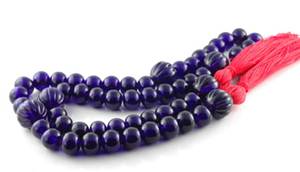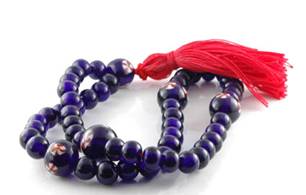

A Selection of Medieval Glass Rosaries
Lochac Midwinter Coronation XLIV
Barony of Stormhold
By Lady Arganhell merch Briauc
Beads have been used to assist the faithful with their prayers since ancient times, in many religions. It is not known whether Christians acquired the use of prayer beads from Muslims during the Crusades, or whether they were invented independently by both religions. The term ‘bead’ actually derives from an Old English word ‘bede’, meaning to pray or request.
In early times, pebbles moved from one pile to another assisted the devout to count their prayers and meditations. Throughout the years, this developed to a series of knots on a cord, to rings sewn onto a strip of leather and finally to strands of beads, which eventually became quite decorative and elaborate. The first recorded reference to prayer beads in Europe was in 1075, when Countess Godgifu (remembered as Lady Godiva) willed “a circlet of gems that she had threaded on a string, in order that by fingering them one by one as she recited her prayers, she might not fall short of the exact number” to a Monastery in Coventry. In the 12th Century, it began to be more common to see people carrying a ‘Paternoster cord’. In the 13th Century their use is more widespread, and they are becoming very elaborate (so much so that in 1261, the Domicans forbid lay brothers to ‘give themselves airs’ by carrying excessively grand prayer beads). Guilds for Paternosters (makers of rosaries) also began to be formed. In the 14th century, personal rosaries became standard possessions, and by the end of the medieval period they are probably the most common item of jewellery, owned by people of all classes. In some societies, a person may not be considered ‘Christian’ unless their rosary was visible. The modern format of 165 beads - 150 Aves, separated into decades with 15 gaudes, strung in a loop and ending in several free hanging beads and a crucifix, was fixed by Pope Pius V in 1569.
In Medieval Europe rosary beads were made from wood, bone, glass, semi-precious stones such as agate or jet, amber, coral, silver, pearls, gold and precious gemstones. Amber and glass beads were extremely common, although coral was the most sought after, as it was also believed to ‘strengthen the heart’ and have healing properties, but it was costly. Glass and semi-precious stones were often used to imitate more valuable stones such as coral, pearls and amber. Bone and wood were the most basic materials, and bone prayer beads, in particular, were produced in vast quantities.
Medieval rosary beads could be round, oval, cylindrical, flattened squares or lozenge shaped, decorated or plain. The smaller ‘Ave’ beads were usually smooth rather than faceted, and the ‘Gauds’ or marker beads were often larger and more elaborate or valuable. Gauds could be almost any design. Square, cylindrical and ribbed ones appear, as do pictorial forms such as shells, flowers, ears of grain, hearts, and skulls. The most common number on a strand was 50, with or without Gauds, but also strings of 10, 15, 20, 33, 63, 72 and the full rosary of 150 were found.
Rosaries could be strung on silk, cotton, linen or woollen thread, cords or ribbon, which were often red, to represent ‘blood, destiny and the power of Pentecost’. Examples are also recorded threaded on black, green, bright pink and gold. Rosaries generally appear to move somewhat freely on their cord, to facilitate counting, rather than being individually knotted in place. They could be threaded on an open ended, linear form, or as a loop or ‘chaplet’. It appears that it was more common for men to use the linear style, and they often carried very short strands such as ‘tenners’.
Rosaries commonly ended in a silk tassel, or may have a crucifix, religious medal or small figure of a saint. Rosaries could also include additional items such as heart medallions, relics, good luck charms, secular jewellery (such as a brooch to attach it to clothing), a purse, bells, tiny flasks of holy water or pomanders.
Rosaries could be worn hanging from the belt; loose or in a relic pouch, wrapped around the forearm, worn as a bracelet, pinned to clothing, worn across the chest like a bandolier, as a necklace, or simply held in the hands.
I have decided to produce a range of Rosaries, exhibiting various styles and approaches to using glass beads in medieval rosaries. As a Paternoster, I have made all of the beads myself using a technique known as lampworking. Apart from the use of a modern heat source, in the form of my surface mix torch, the process is very similar to what it would have been in period times. Molten glass is wrapped around a metal mandrel, which has been coated in ceramic slip, and formed into the desired shape. Decoration can be applied by adding other colours of glass, such as ‘murrini’ cane, or by manipulating the surface of the glass – changing its shape, or cutting into it with a sharp object.
Linear Strand of 55 blue beads with ribbed Gaudes.
I selected blue glass for this strand as blue glass rosary beads have been found in a 13th Century English grave, and a 14th Century London Jeweller, Adam Ledyard, stocked blue glass Ave beads. I chose the grooved form for the Gauds as ‘ribbed’ beads were specifically mentioned as Gauds in one source, and I have photographed Latvian beads (in the British Museum) from the 10-12th Century with that design, showing that the beadmaking technique was available and in use in Europe before this time.
I chose to create this strand in a linear form, which was popular (and thought to be preferred by males) with a tassel at each end, which my reading, and paintings from the time, showed was common. The beads are strung on a red satin ribbon with cotton tassels. (I was unable to access silk ribbon, or silk thread for tassels which may have been used in period) as red was often used to represent blood, destiny and the power of Pentecost’.
50 Ave beads, or 5 ‘decades’ divided by paternoster, gaude or ‘marker’ beads was a very common number for rosaries. The full rosary is 150 prayers, so a rosary this size could be easily used to measure that number, and did not have the weight and expense of a full strand.


Chaplet of 55 blue beads with Murrini decorated Gaudes.
I selected blue glass for this rosary for the reasons listed above. Records indicate that in 1279, Bavarian men were sent to Venice to buy ‘glass cane for the production of paternoster beads’. Venice was known to sell Murrini cane for use in other beadmaking centres in Europe. I have chosen to interpret this brief reference to mean that Italian Murrini cane could have been used to make Paternoster or Gaude beads, and I have created a simple Murrini in a design I have seen on 8th-12th Century Viking beads (who were also known to buy Murrini cane from Italy), showing that the technique and design was available and in use in Europe at this time. The visual references I have seen are either paintings, which were generally of the ‘rich and famous’ who would generally use Coral or precious stones for Rosary beads, or woodcuts, which have no colour or decoration detail. This makes it difficult to have definitive information about what the glass paternoster beads would have looked like. I have not seen any images of extant finds in this area.
This strand is strung in a loop or ‘chaplet’, the other most common way of assembling rosaries. The beads are strung on a red satin tubular ribbon with a cotton tassel. (I was unable to access silk ribbon, or silk thread for tassels which may have been used in period).
50 Ave beads, or 5 ‘decades’ divided by paternoster, gaude or ‘marker’ beads was a very common number for rosaries. The full rosary is 150 prayers, so a rosary this size could be easily used to measure that number, and did not have the weight and expense of a full strand.



Linear strand of 20 imitation amber beads, with cylindrical Gaudes.
I wanted to demonstrate the various ways glass was used in rosaries, and a range of ways that they were strung. This strand shows how glass could be used to imitate a more expensive and sought after material, in this case amber (a very popular material for rosary construction). The cylindrical gaudes demonstrate another documented form of marker bead. Shorter strands of 20 beads, with or without gaudes, have been found. Various numbers of beads were used in rosaries depending on the number of devotions that the user undertook. This rosary also depicts how some strands in period were decorated with crucifixes and/or tassels.


Linear strand of 10 imitation coral beads
Rosaries were found as short as 10 beads, which were especially popular for men, and were known as ‘tenners’. Coral was the most popular material for rosaries but was very expensive and not accessible to all. These are threaded on green cotton thread, with a tassel. I have chosen to put a loop in one end, as the strand is too short to be worn draped over a belt. In period, a strand like this may have been carried in a relic pouch.

I have also created the following rosary on a commission for the incoming Baroness of Stormhold. It combined the amber ave beads with the blue ribbed gaudes, and a tassel in Stormhold colours. In period, the tassel would generally be a solid colour, to match the cord.


Bibliography
Paternoster Row: Historical Rosaries and Paternosters
http://paternoster-row.org
The Medieval Rosary
http://www.pomian.demon.co.uk/rosary.htm
Rosary Workshop
http://www.rosaryworkshop.com/HISTORYjournalingBead.htm
The Medieval Rosary
http://aelflaed.homemail.com.au/doco/rosaries2.html
Prayer Bead Production and Use in Medieval England
http://www.rosetta.bham.ac.uk/Issue_04/Gottschall.htm
A Trio of Paternosters: Catholic Devotional Beads of the Middle Ages
http://www.fridayvalentine.com/rafaella/kingdom_AS/rosary.pdf
‘A History of Beads: From 30,000 BC to the Present’ Louis Sherr Dubin
A Bead Timeline